Key takeaways
- Global classrooms foster empathy and understanding by connecting students across cultures, breaking down stereotypes, and nurturing relationships.
- Engaging students in collaborative projects and meaningful dialogue fosters critical thinking and prepares them for participation in a diverse world.
- Overcoming challenges like technology glitches and cultural misunderstandings can enhance resilience and promote deeper learning experiences.
- Sustaining global connections requires intentional efforts, such as regular check-ins and celebrating cultural moments, to deepen bonds among students.

Understanding global classrooms
Global classrooms are more than just digital meeting spaces; they are vibrant hubs where diverse cultures, ideas, and perspectives collide. I remember the first time my students connected with peers from another country—it was like watching curiosity and empathy bloom in real time. Have you ever noticed how a simple conversation can spark a deeper understanding of the world beyond textbooks?
What strikes me most about global classrooms is their power to break down stereotypes and build genuine relationships. When students share stories about their daily lives, challenges, and dreams, it becomes clear how much we all have in common. Isn’t it incredible how these connections can transform the way young people see themselves and others?
At their core, global classrooms foster a sense of belonging to a wider human community. From my experience, students grow more confident and engaged when they realize their voices matter on a global stage. This is the kind of learning that stays with you long after the lesson ends.
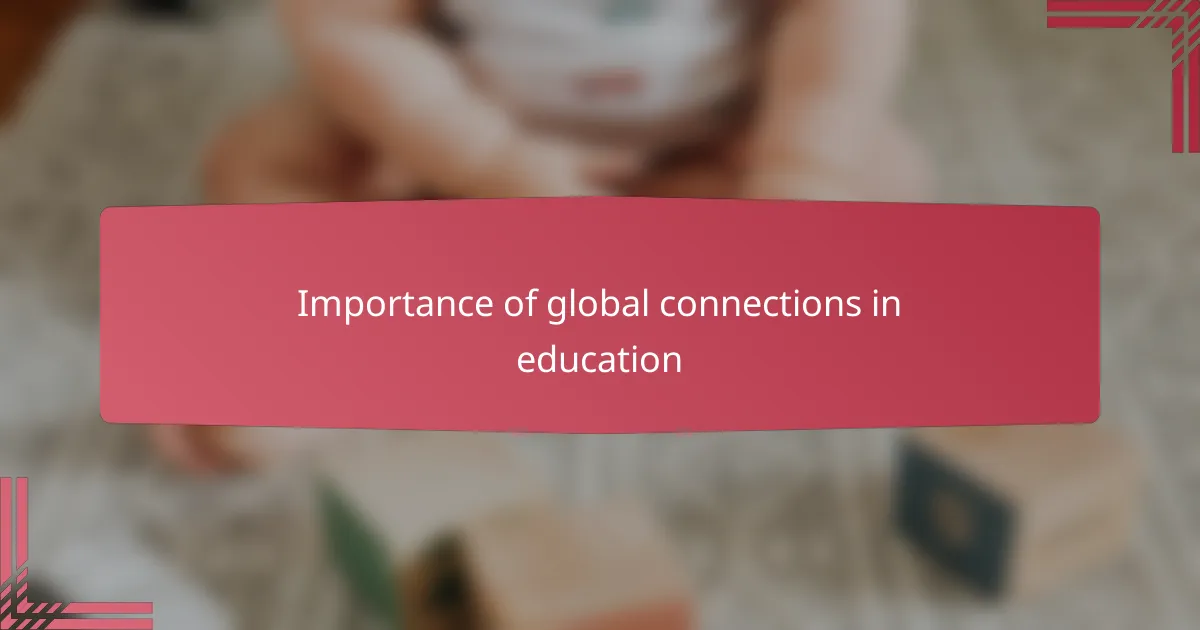
Importance of global connections in education
When I think about the importance of global connections in education, what stands out most is how they expand students’ horizons beyond their familiar surroundings. It’s like opening a window and letting fresh air and new ideas come rushing in. Have you ever noticed how kids become more curious and open-minded simply by hearing different perspectives firsthand?
In my experience, these connections nurture empathy in ways that traditional lessons rarely achieve. One time, a student told me that talking with a peer from halfway across the world helped them realize that difficulties at home weren’t unique or insurmountable. That moment made me see just how powerful global dialogue can be for building resilience and understanding.
Another thing I’ve learned is that global classrooms prepare students to be active participants in an interconnected world. When they engage with diverse cultures and viewpoints, they start thinking beyond borders and stereotypes. Isn’t that exactly the kind of critical thinking and compassion our future needs?
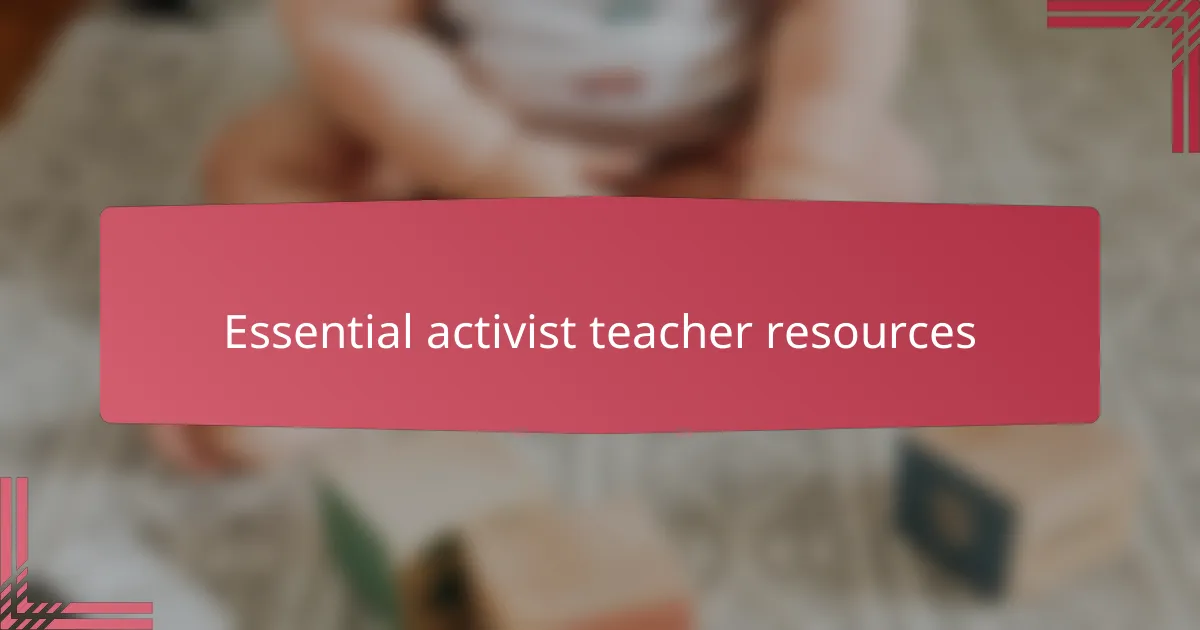
Essential activist teacher resources
When I first began searching for activist teacher resources to support global connections, I was struck by the wealth of tools designed to foster meaningful dialogue rather than just surface-level exchanges. Have you ever found that a well-crafted lesson plan or a curated reading list can make all the difference in helping students see the world through others’ eyes? These resources don’t just inform; they inspire students to act with empathy and justice.
One resource I always rely on is multimedia content created by educators and activists from different parts of the world. Using videos or podcasts that share authentic voices makes the learning experience richer and more immediate. I remember my students’ faces lighting up the moment they heard a peer describe daily life in a distant country—it was a powerful reminder that connection starts with genuine storytelling.
Another essential resource is professional communities where teachers can exchange ideas and experiences about building global classrooms. In these spaces, I’ve discovered creative strategies and tools that I never would have found on my own. Isn’t it encouraging to know that, as activist educators, we’re part of a collective movement pushing for deeper, more compassionate global learning?
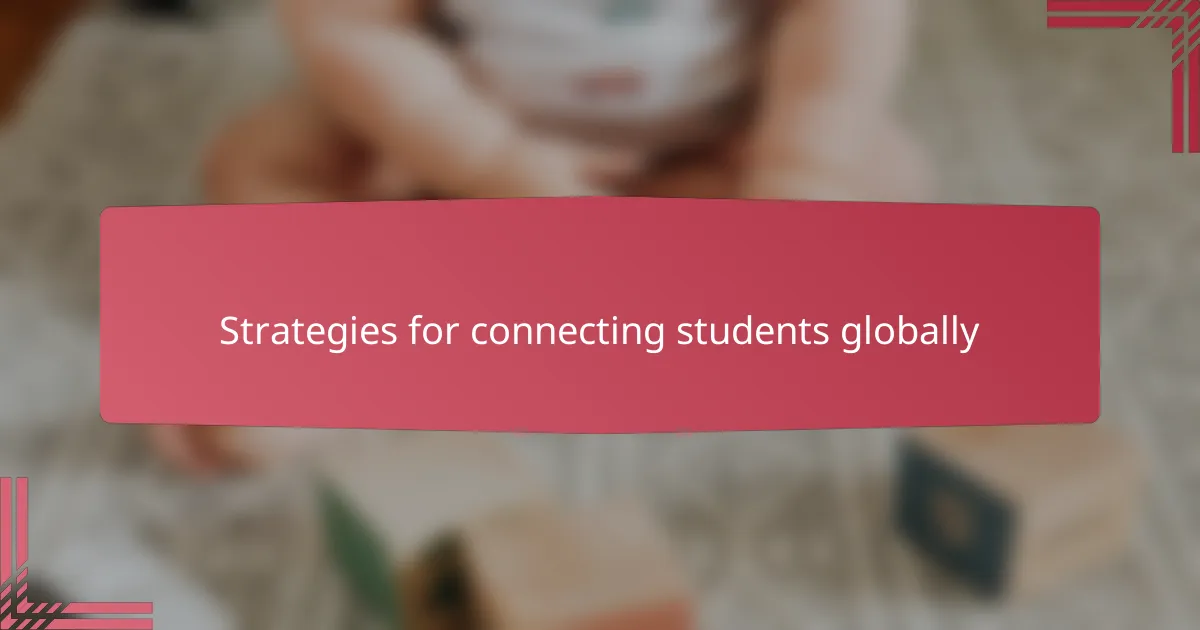
Strategies for connecting students globally
One strategy I find incredibly effective is starting with collaborative projects that require students to solve real-world problems together. When my class teamed up with peers abroad to design solutions for local environmental issues, the enthusiasm was contagious. Doesn’t working side by side on something meaningful make the world feel just a little smaller?
I also believe that using asynchronous tools like shared blogs or video diaries can open up ongoing conversations that transcend time zones. I recall a student telling me how reading a peer’s video diary from another country made their own struggles feel less isolating. Isn’t it amazing how storytelling bridges gaps beyond immediate interactions?
Lastly, organizing live virtual exchanges with clear guidelines encourages respectful curiosity and cultural humility. From my experience, prepping students with thoughtful questions beforehand helps conversations flow more naturally and deeply. Have you noticed how these moments of genuine dialogue often become turning points in students’ global awareness?
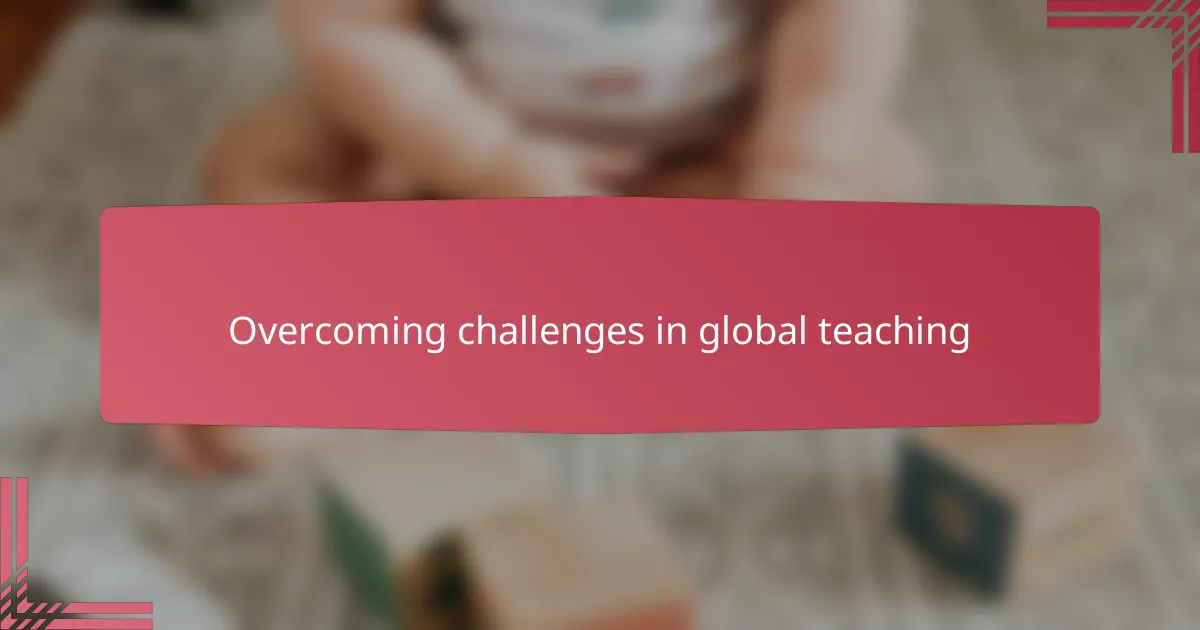
Overcoming challenges in global teaching
I’ve faced my fair share of hiccups when connecting classrooms across continents—technology glitches, mismatched schedules, and even language barriers. But what I’ve learned is that patience and flexibility go a long way. Have you ever found that when you embrace these bumps as learning moments, both you and your students gain resilience and creativity?
Sometimes, the biggest challenge is cultural misunderstandings that pop up unexpectedly. I remember a time when a comment from one student was misinterpreted by their peer abroad, causing confusion. It was an eye-opener for all of us about the need for clear communication and setting the stage for respectful dialogue. Don’t you think these moments teach empathy just as much as the planned lessons?
Another hurdle is keeping everyone engaged when physical distance makes connections feel less personal. I found that using multimedia and storytelling helped bridge that gap beautifully. When students share videos or photos about their lives, it sparks curiosity and makes those global friendships real. Isn’t it amazing how a simple story can transform a screenspace into a vibrant community?
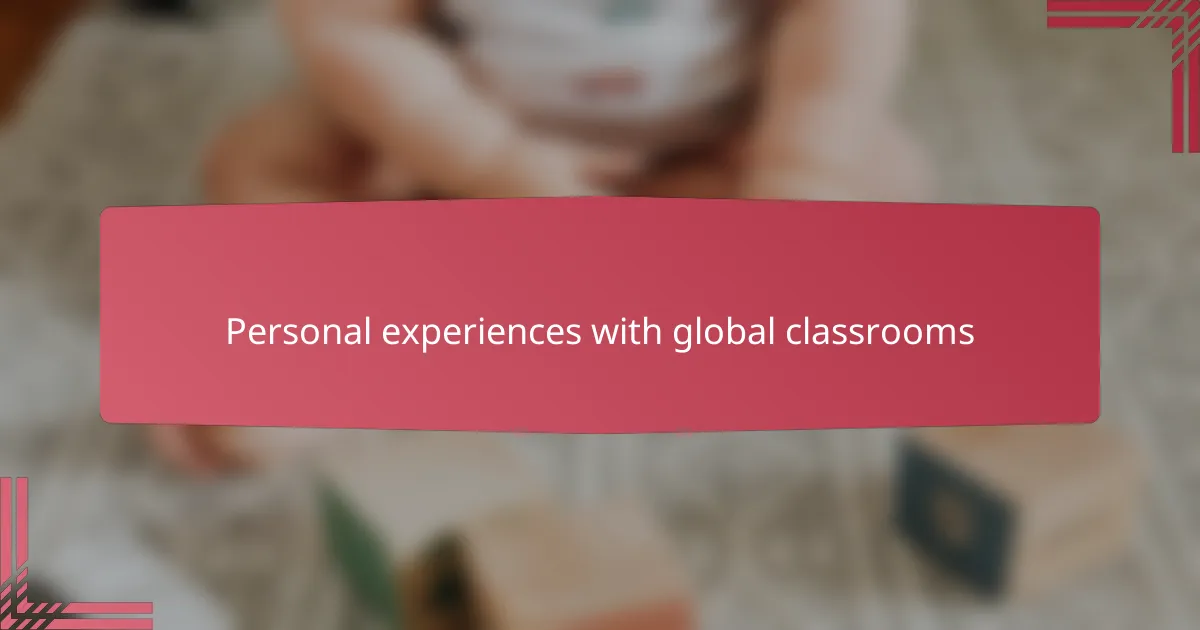
Personal experiences with global classrooms
One of my most vivid memories with global classrooms was when my students collaborated in a live video call with a group from a small village halfway across the world. Watching their faces light up as they exchanged jokes and shared daily routines reminded me how powerful these connections are. Have you ever seen young learners realize that friendship can cross oceans in an instant?
I also recall a moment when a shy student, usually hesitant to speak up, found confidence through a shared online project with peers abroad. Hearing feedback and encouragement from unfamiliar voices seemed to unlock something within them. Doesn’t it fascinate you how global interactions can nurture personal growth in unexpected ways?
Sometimes, the deepest learning came after challenges, like when a cultural misunderstanding arose between two classrooms. Rather than shutting down, we used that moment to discuss respect and perspective with the students. That experience stuck with me as proof that global classrooms are not just about knowledge—they’re about building empathy brick by brick.
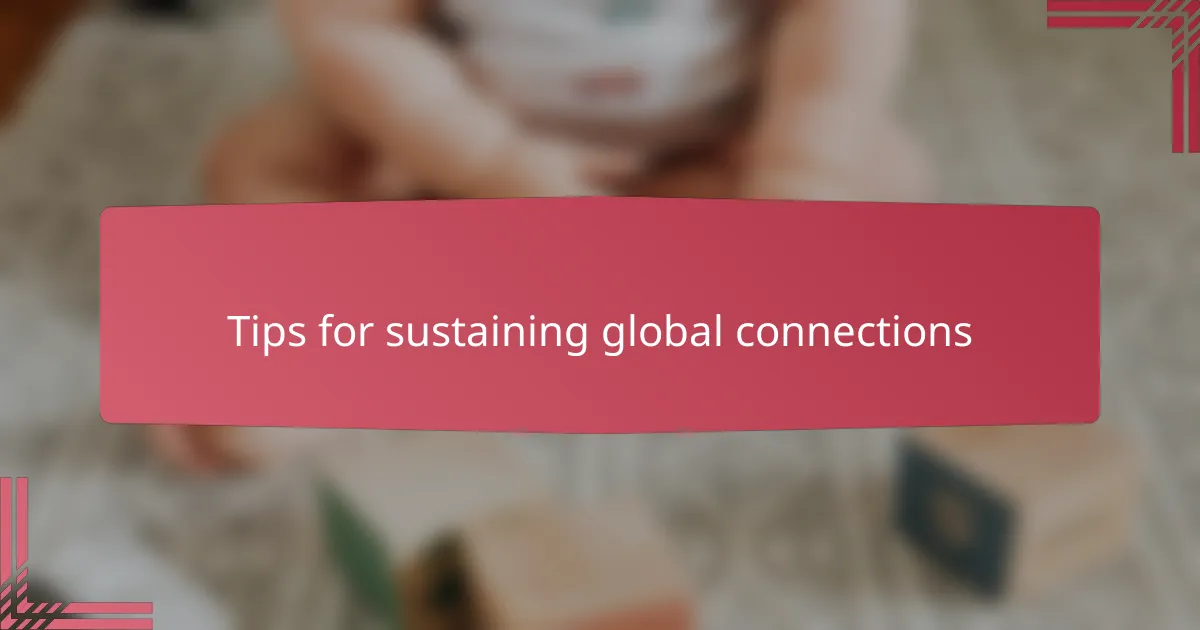
Tips for sustaining global connections
Sustaining global connections takes intentional effort, much like nurturing any meaningful relationship. I’ve found that scheduling regular check-ins, even brief ones, helps keep the momentum alive. Have you ever noticed how consistency builds trust and anticipation, turning distant peers into reliable collaborators?
Another tip that’s worked well is celebrating small cultural moments together—whether it’s sharing a festival, a recipe, or a holiday tradition. I remember my students eagerly planning virtual celebrations with their global friends; those moments transformed abstract connections into heartfelt exchanges. Isn’t it incredible how shared celebrations deepen bonds beyond the screen?
Finally, staying curious and open when challenges arise keeps the connection authentic and resilient. When technical hiccups or misunderstandings happen, I encourage students to see them as opportunities to practice patience and empathy. From my experience, these bumps often become the stories that make the global partnership richer and more human.